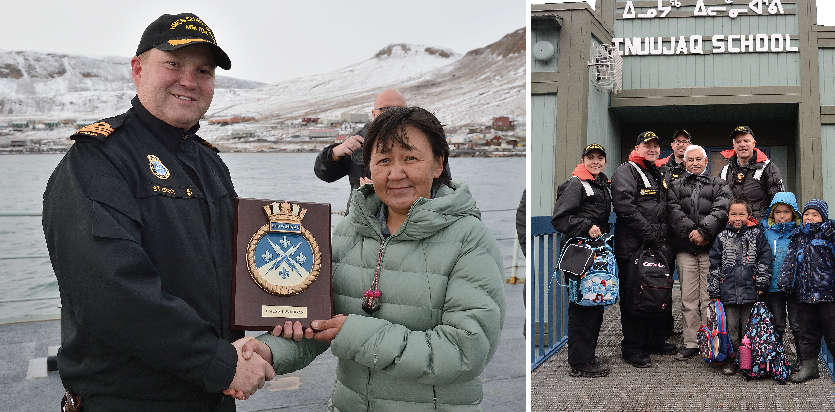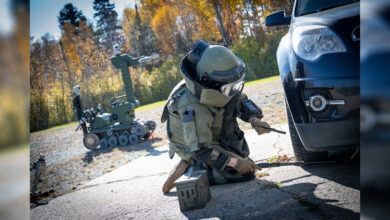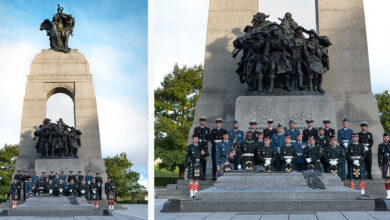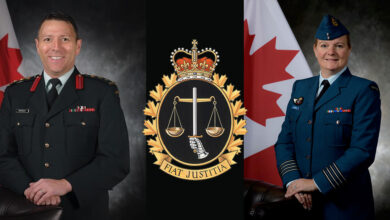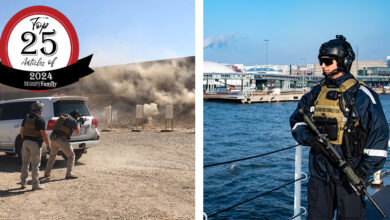Duty CallsUncategorized
HMCS Shawinigan and HMCS Moncton successfully carrying out mission in the Arctic
Sailing through the icebergs and connecting with local communities, Her Majesty’s Canadian Ship (HMCS) Shawinigan and her crew have been successfully carrying out their mission in Arctic waters over the past month.
HMCS Shawinigan, along with HMCS Moncton, departed from their home port of Halifax, NS on Aug. 11. HMCS Shawinigan departed with a mission to chart ocean floors in the Arctic, conduct sovereignty patrols and build a pattern of life for shipping in the area as the northwest passage became more navigable this season.
The first major stop for the ship and her crew was in the small community of Arctic Bay. The Royal Canadian Navy (RCN) has established relationships with this small Arctic community and during their stay the crew met with elders of the community, opened up the ship for tours and spoke to high school students about the RCN and their operations in the area.
As part of their visit to Arctic Bay, HMCS Shawinigan also donated backpacks to the children of the community.
The idea is the brainchild of Chief Petty Officer 2nd class Richard Bungay, who was inspired by local traditions.
“We were ashore and we see one of the elders cleaning his catch of the [Arctic] char. We were talking to him and he just offered us the Arctic char and we said we’ll pay you of course and he said ‘no no that’s not what we do we share stuff’,” said Bungay.
Touched by the act of generosity coupled with the old tradition of the HMCS Labrador in the 1950s to bring donations for children, Bungay decided to carry on the tradition in a new manner.
Supported by the RCN, Bungay is able to involve the local military community in Halifax with this project. This year a total of 75 backpacks were donated.
Bungay says items can get costly in the Arctic and the donations also help to increase the relationship between the RCN and the community.
“Everywhere we go up there people are genuinely friendly and are our fellow Canadians,” noted Bungay.
From Arctic Bay, the crew then set sail towards King William Island to chart the ocean floor there. Close to 80 square miles of ocean floor, just over 800 linear miles of ocean floor, were charted during their mission.
“[It’s] basically to increase our knowledge of the ocean floor for shipping through the area and to identify any areas that may be hazardous to marine shipping as the northwest passage becomes more navigable,” stated LCdr Dale St. Croix, Commanding Officer of the Shawinigan.
On their way back from the Island, the crew was tasked with responding to a search and rescue call. Four hunters had been stranded under heavy wind and seas at, and though the seas were too treacherous for the HMCS Shawinigan to rescue the hunters, the crew was able to drop off survival supplies and stay in communication with the group until help came the next morning.
Though St. Croix has sailed through the Arctic many times, he says the beauty of the land doesn’t fade.
“The biggest thing really is the overall majesty of the topography of the Arctic. It’s almost like you’re sailing through the Rockies as you go through and you’re passing through small channels and the water below you is 400/500 meters deep and next to you have this large mountain range that extends up and you’re only half a mile from the coast. The biggest majesty of it is just the the fact that it’s almost like you’re sailing through a mountain range and you’re going through the arctic,” described St. Croix.
But with the beauty comes the unpredictable and sometimes treacherous weather. HMCS Shawinigan was forced to cut their mission down a few days for fear of an incoming storm.
“What I’ve learned is the Arctic is all about the environment and the weather changes much more rapidly in the Arctic than it does down south. Of course ice is always a big danger,” explained St. Croix.
The HMCS Shawinigan travelled a total of 11,000 miles and will be back at home port by Sept. 30 after rendezvous with HMCS Moncton.
“It’s been a very successful mission and the crew definitely enjoyed it. It’s been very eye opening for a lot of the crew not only to see how people live in the arctic but to experience the weather, experience life in article to see glaciers and icebergs and see a part of Canada that a majority of Canadians never get to see,” said St. Croix.


